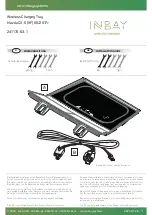
Tire Pressures when Towing
When towing a trailer, tire pressures must be
adjusted to accommodate the additional load.
Keep tires inflated to the pressures shown
below (these pressures override the pressures
that are provided on the Tire and Loading
information label):
Front Tires
Rear Tires
Cold Tire
Inflation
Pressure
255/45R20
265/45R20
275/45R20
46 psi (320
kPa)
265/35ZR22 285/35ZR22
50 psi (345
kPa)
WARNING:
Check tire pressures using
an accurate pressure gauge when tires
are cold. Driving one mile (1.6 km)
warms the tires sufficiently to affect
tire pressures. Parking the vehicle in
direct sunlight or in hot weather can
also affect tire pressures. If you must
check warm tires, expect increased
pressures. Do not let air out of warm
tires in an attempt to match
recommended cold tire pressures. A
hot tire at or below the recommended
cold tire inflation pressure is
dangerously under-inflated.
WARNING:
Never attempt to tow a
trailer when a Model X tire is faulty or
has been inflated using a tire repair kit.
A temporarily repaired tire is not
designed to sustain the towing load.
Towing using a faulty or temporarily
repaired tire can result in tire failure
and loss of vehicle stability.
Before Towing a Trailer
Before towing a trailer, you must do the
following:
• Inflate tires to the cold tire inflation
pressure specified in Tire Pressures when
Towing.
• Set Suspension to
Standard
height (touch
Controls
>
Suspension
>
Standard
).
• Observe all regulations and legal
requirements in your state/region that
apply to trailer towing. Failure to comply
with regulations can compromise your
safety.
• Adjust side mirrors to provide a clear
rearward view without a significant blind
spot.
• Engage
Trailer Mode
(see
).
Confirm the following:
• Model X rests horizontally with the trailer
attached. If the vehicle is tipped up at the
front, and down at the rear, check that
you are not exceeding the maximum
towing capacity and tongue loads
provided in Carrying Capacity.
• All trailer hitch parts and attachments ,
safety chains, and electrical connectors
are in good condition and are properly
connected. If any problems are apparent,
do not tow the trailer.
• Trailer lights (brake lights, turn signal
lights, and marker lights) are working
properly.
• The trailer tongue is securely connected
to the hitch ball.
• Safety chains are properly connected
between the trailer and the tow vehicle.
Cross the safety chains under the tongue
of the trailer to help prevent the tongue
from contacting the road if it separates
from the hitch. Leave enough slack in the
safety chains to allow for turns and
ensure that the chains can never drag on
the ground.
• All cargo is secured.
• Wheel chocks are available.
• The trailer load is evenly distributed such
that the trailer tongue weight is
approximately 10% of the total trailer
weight, without exceeding the maximum
tongue weights provided in Carrying
Capacity.
• If the trailer is equipped with a separate
braking system, check that the brakes
work and are properly adjusted. To
provide safe stopping ability, you must
balance the trailer brakes with the vehicle
brakes.
Towing and Accessories
92
MODEL X Owner's Manual
















































